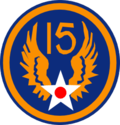827th Bombardment Squadron
827th Bombardment Squadron
 | |
|---|---|
| Active | 1941-1945 |
| Country |
|
| Branch | United States Army Air Forces |
| Role | Bombardment |
| Engagements |
Antisubmarine Campaign Mediterranean Theater of Operations[1] |
| Decorations | Distinguished Unit Citation[1] |
| Insignia | |
| 827th Bombardment Squadron Emblem (approved 11 July 1942)[1] |
_emblem.png) |
| Early 41st Bombardment Squadron emblem |
_emblem_(early).png) |
The 827th Bombardment Squadron is an inactive United States Air Force unit. It was last assigned to the 484th Bombardment Group at Casablanca Airport, French Morocco, where it was inactivated on 25 July 1945.
The squadron was first activated as the 41st Bombardment Squadron as the United States expanded its military following the outbreak of World War II. Following the attack on Pearl Harbor, the squadron performed antisubmarine warfare missions off the Atlantic coast of the United States, and was redesignated as the 5th Antisubmarine Squadron.
After the Army Air Forces antisubmarine mission was transferred to the Navy, the squadron acted as the cadre for anew Consolidated B-24 Liberator group as the 827th Bombardment Squadron. It served in combat in the Mediterranean Theater of Operations until V-E Day, earning two Distinguished Unit Citations for its combat actions.
History
Organization and antisubmarine warfare
The squadron was first activated at Langley Field, Virginia in January 1941 as the 41st Bombardment Squadron, one of the original squadrons of the 13th Bombardment Group. The squadron was equipped with a mix of Douglas B-18 Bolos and North American B-25 Mitchells. In June, the 41st and its parent group moved to Orlando Army Air Base, Florida.[1][2]
After the attack on Pearl Harbor, the squadron was ordered to search for German U-Boats off the southeast coast. Although the Navy was responsible for long range patrolling, it lacked the aircraft to perform the mission and the Army Air Forces (AAF) performed the mission, even though its crews lacked proper training.[3] As antisubmarine warfare assets were realigned to meet the growing threat in the North Atlantic, the 13th Group moved to Westover Field, Massachusetts.[1][2]
In October 1942, the AAF organized its antisubmarine forces into the single Army Air Forces Antisubmarine Command, which established the 25th Antisubmarine Wing the following month to control its forces operating over the Atlantic.[4][5] Its bombardment group headquarters, including the 13th, were inactivated and the squadron, now designated the 5th Antisubmarine Squadron, was assigned directly to the 25th Wing.[1][2] In July 1943, the AAF and Navy reached an agreement to transfer the coastal antisubmarine mission to the Navy. This mission transfer also included an exchange of AAF long-range bombers equipped for antisubmarine warfare for Navy Consolidated B-24 Liberators without such equipment.[6]
Combat in the Mediterranean
After the Navy assumed full responsibility for the antisubmarine mission in August 1943, the squadron was transferred to Second Air Force, where it was redesignated the 827th Bombardment Squadron[1] and formed the cadre for a Consolidated B-24 Liberator heavy bombardment group. After training, the squadron deployed to the Mediterranean Theater of Operations (MTO) in April 1944, where it became part of Fifteenth Air Force in Southern Italy.[1]
Despite its Pathfinder designation, the squadron did not perform pathfinder missions. Instead it engaged in very long range strategic bombardment missions against enemy strategic targets in Italy, France, Germany, Austria, Czechoslovakia, Hungary, and the Balkans until April 1945. The 827th bombed aircraft factories, assembly plants, oil refineries, storage areas, marshaling yards, airdromes, and other objectives until the German Capitulation in May 1945.
The squadron became part of Air Transport Command in May 1945. It used B-24s as transports flying personnel from locations in France and Italy to Casablanca, French Morocco. It also engaged in transport operations from North Africa to Azores or Dakar in French West Africa where personnel eventually were transported to Florida. The squadron inactivated in French Morocco during July 1945.[1]
Lineage
- Constituted as the 41st Bombardment Squadron (Medium) on 20 November 1940
- Activated on 15 January 1941
- Redesignated 5th Antisubmarine Squadron (Heavy) on 29 November 1942
- Redesignated 827th Bombardment Squadron (Heavy) on 1 October 1943
- Redesignated: 827th Bombardment Squadron (Pathfinder) on 14 February 1944
- Redesignated: 827th Bombardment Squadron, Heavy on 11 November 1944
- Inactivated on 25 July 1945[1]
Assignments
- 13th Bombardment Group: 15 January 1941
- 25th Antisubmarine Wing: c. 30 November 1942
- 484th Bombardment Group: 1 October 1943 - 25 July 1945[1]
Stations
|
|
Aircraft
- Douglas B-18 Bolo, 1941
- North American B-25 Mitchell, 1941-1943
- Lockheed A-29 Hudson, 1942-1943
- Consolidated B-24 Liberator, 1943–1945[1]
References
Notes
Bibliography
![]()
- Ferguson, Arthur B. (April 1945). "The Antisubmarine Command, USAF Historical Study No. 107" (PDF). Assistant Chief of Air Staff, Intelligence Historical Division. Retrieved September 12, 2016.
- Maurer, Maurer, ed. (1983) [1961]. Air Force Combat Units of World War II (PDF) (reprint ed.). Washington, DC: Office of Air Force History. ISBN 0-912799-02-1. LCCN 61060979.
- Maurer, Maurer, ed. (1982) [1969]. Combat Squadrons of the Air Force, World War II (PDF) (reprint ed.). Washington, DC: Office of Air Force History. ISBN 0-405-12194-6. LCCN 70605402. OCLC 72556.